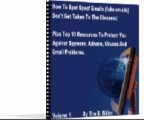
 License Type: Resell Rights
License Type: Resell Rights  File Size: 76,976 KB
File Size: 76,976 KB File Type: ZIP
File Type: ZIP
 SKU: 30797
SKU: 30797  Shipping: Online Download
Shipping: Online Download
Ebook Sample Content Preview:
TROUBLE SHOTS
Because golf is such a complicated - yet easy - game, you may find yourself in some situations that seem impossible to get out of. We call these trouble shots. They can be frustrating and can add to your score in record proportions. Here are some trouble shots we've encountered and ways that you can approach them.
Deep Rough
Long grass has the effect of closing the face of the club and decreasing the loft of the club. For this reason, the player should use a more lofted club than if the ball were in the fairway. If a player has a long distance left, the first consideration should be getting the ball out of the rough. Use of lofted fairway woods #5, #6, #7 is advisable in this situation.
The long grass will decrease the loft of these clubs and the ball will actually go the distance of the less lofted fairway woods. Around the green, the player must again use a more lofted club. These types of shots are custom made for a wedge or a 9-iron. The effect of the long green will once again decrease the loft of the club. The ball will therefore fly lower and run more than if it were in the fairway. Remember; allow the loft of the club to lift the ball out of the rough!
Side hill, Downhill, and Uphill Lies
Nothing can be more frustrating than having a golf shot on a slanted surface. The way many golf courses are laid out, you will probably have to deal with a lie like this at some point in your game. But you can deal with hilly lies with no problems and a little advice.
Take a practice swing and note where the club is striking the ground. If the club is striking the ground nearer the back foot, move the ball back in your stance; if the club is striking the ground nearer the front foot, move the ball forward in your stance. This system is the most accurate system to determine where the ball should be placed in the stance. Seldom does a player have a purely side hill or uphill lie. This system takes all the factors into account as the practice swing is the forerunner to the actual shot.
The general rule of thumb is to position the ball in the stance nearer the higher foot on the downhill lies, and about center on the uphill lies. On side hill lies, position the ball left center (as you normally would). If the ball is above your feet on the side hill lie, you will normally hit the ball straight or pull it to the left. If the ball is below your feet, most players will actually pull the ball to the left because their leg action will slow down as they try to maintain their balance.
You will want to have a longer club than you would usually use for an uphill shot (a 4 instead of a 5). Choke down on the club and put more flex in your left knee (if you are right handed). Much of your weight should be on your front leg. Remember that the ball will generally go to the left, so aim to the right of the target. Position the ball slightly ahead of center and swing in a slow deliberate way maintaining your balance.
For downhill lies, you will want a shorter club than you would normally use (a 6 instead of a 5). The ball will go right, so aim to the left of the target. Position the ball so that it is back in your stance.
Put most of your weight again on the forward foot. Have some flex in your right knee and then swing slowly and deliberately maintaining your balance.
Side hill shots are probably some of the worst in golf. If you are faced with a side hill shot where the ball is below your feet, you will need a longer club than you would usually use. Set up closer to the ball when you address it and increase the flex in both of your knees. The ball will go to the right, so aim left of the target and, again, maintain your balance with a slow, deliberate backswing.
When the ball is above your feet on a side hill shot, the stance is slightly different. You will still want a longer club than usual, but you will choke down on the shaft. Stand more upright and put more weight on your toes. The ball will go left, so aim right of the target and maintain a slow and deliberate backswing as you should be doing in all hill shots.
Restricted Back Swing
There are times when you will have a shot that will restrict your back swing. Let's say that your ball ends up next to a tree. You won't be able to take a normal back swing because the tree is in the way. You will have to make some modifications in order to get yourself out of this trouble shot. Luckily, it's not as difficult as you might think.
First position yourself so that you can get to the ball and still aim at your target. Practice a couple of backswings to see how far you can take the club back without bringing the tree into play. Then keep that distance first and foremost in your mind. You will need to cock your wrists and keep them cocked throughout whatever backswing you will be able to muster up.
Make a normal down swing, knowing that the club has room to miss the tree trunk and you will advance the ball into scoring position. The idea here is to just get away from the tree completely so you're not worrying about distance or even accuracy for that matter. All you want to do is get the ball back in the fairway so you can save your score.
Hitting Out of Water
The main rule of thumb when you have a ball in water is to just let it be and not try to hit out of it. However, if it truly is playable in shallow water, you may want to go ahead and try to hit it out and save yourself a stroke.
- File Size:76,976 KB
- License: Resell Rights
- Category:Ebooks
- Tags:2013 Ebooks With Video Resale Rights







